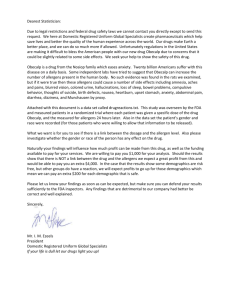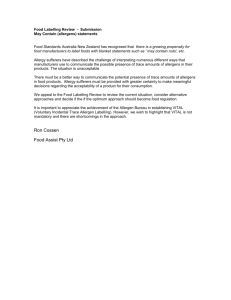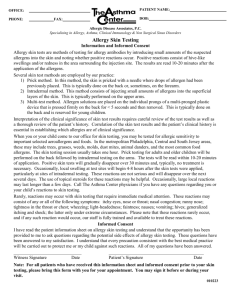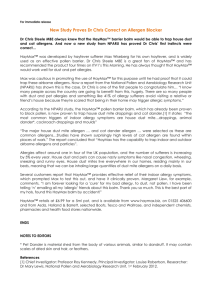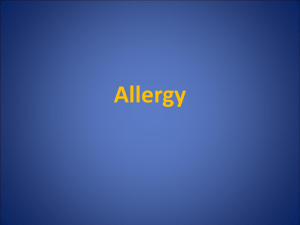School indoor air quality and allergen exposure Peter Fsadni, Stephen Montefort
advertisement
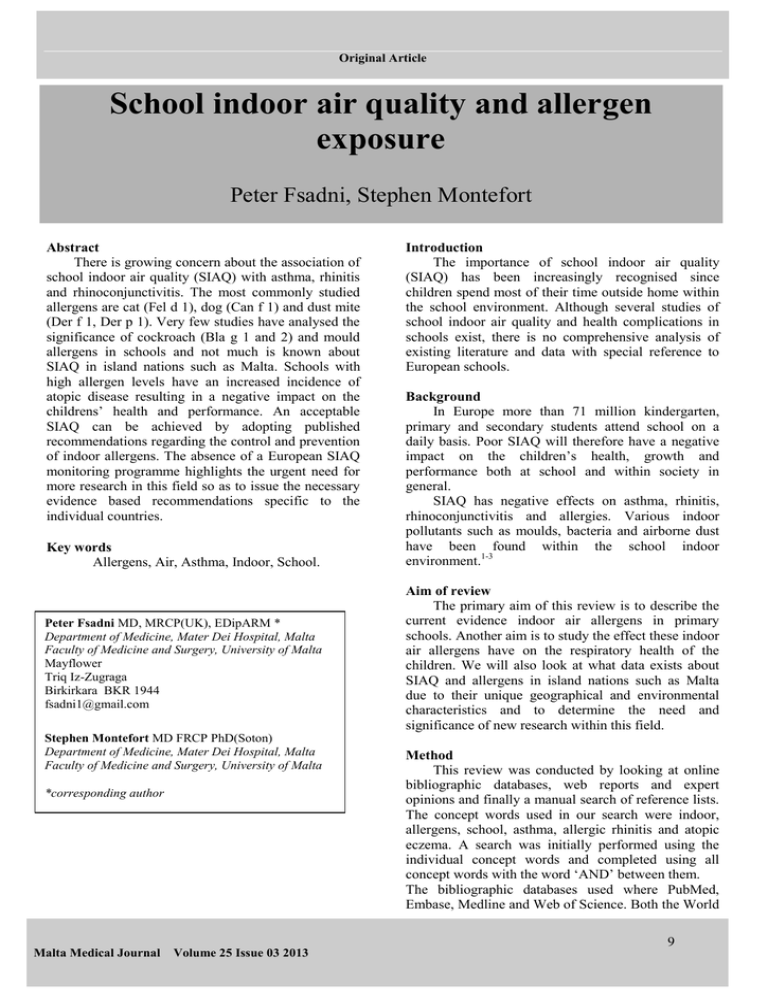
Original Article School indoor air quality and allergen exposure Peter Fsadni, Stephen Montefort Abstract There is growing concern about the association of school indoor air quality (SIAQ) with asthma, rhinitis and rhinoconjunctivitis. The most commonly studied allergens are cat (Fel d 1), dog (Can f 1) and dust mite (Der f 1, Der p 1). Very few studies have analysed the significance of cockroach (Bla g 1 and 2) and mould allergens in schools and not much is known about SIAQ in island nations such as Malta. Schools with high allergen levels have an increased incidence of atopic disease resulting in a negative impact on the childrens’ health and performance. An acceptable SIAQ can be achieved by adopting published recommendations regarding the control and prevention of indoor allergens. The absence of a European SIAQ monitoring programme highlights the urgent need for more research in this field so as to issue the necessary evidence based recommendations specific to the individual countries. Key words Allergens, Air, Asthma, Indoor, School. Peter Fsadni MD, MRCP(UK), EDipARM * Department of Medicine, Mater Dei Hospital, Malta Faculty of Medicine and Surgery, University of Malta Mayflower Triq Iz-Zugraga Birkirkara BKR 1944 fsadni1@gmail.com Stephen Montefort MD FRCP PhD(Soton) Department of Medicine, Mater Dei Hospital, Malta Faculty of Medicine and Surgery, University of Malta *corresponding author Malta Medical Journal Volume 25 Issue 03 2013 Introduction The importance of school indoor air quality (SIAQ) has been increasingly recognised since children spend most of their time outside home within the school environment. Although several studies of school indoor air quality and health complications in schools exist, there is no comprehensive analysis of existing literature and data with special reference to European schools. Background In Europe more than 71 million kindergarten, primary and secondary students attend school on a daily basis. Poor SIAQ will therefore have a negative impact on the children’s health, growth and performance both at school and within society in general. SIAQ has negative effects on asthma, rhinitis, rhinoconjunctivitis and allergies. Various indoor pollutants such as moulds, bacteria and airborne dust have been found within the school indoor environment.1-3 Aim of review The primary aim of this review is to describe the current evidence indoor air allergens in primary schools. Another aim is to study the effect these indoor air allergens have on the respiratory health of the children. We will also look at what data exists about SIAQ and allergens in island nations such as Malta due to their unique geographical and environmental characteristics and to determine the need and significance of new research within this field. Method This review was conducted by looking at online bibliographic databases, web reports and expert opinions and finally a manual search of reference lists. The concept words used in our search were indoor, allergens, school, asthma, allergic rhinitis and atopic eczema. A search was initially performed using the individual concept words and completed using all concept words with the word ‘AND’ between them. The bibliographic databases used where PubMed, Embase, Medline and Web of Science. Both the World 9 Original Article Health Organisation and American Thoracic Society websites where searched for relevant studies. The practical screening criteria used in our search included looking at studies on SIAQ due to allergens published between 1987 and 2012, studies performed in primary schools and manuscripts written in English and Italian were reviewed. Studies dealing specifically with food allergen contamination were eliminated from the review. Methodological screening criteria were utilised so as to include studies that had reliable and valid data sources, appropriate analytical methods and robust and significant statistical analysis. Any studies which did not conform with these practical and methodological criteria were excluded. Allergen exposure in schools and its impact on asthma and atopic disease Asthma is one of the most common conditions diagnosed in children and recent studies have shown that allergens produced by dust mite, cockroach, cats, dogs and fungi all contribute to the development or progression of the disease. 4 The prevalence of wheezing and rhinitis in Maltese 5 to 8 year old school children in 2001 surpassed the global mean with an upward trend seen when compared to the ISAAC Phase 1 data in 1994.5 A negative correlation exists between acute asthma admissions in Malta and mean monthly ambient temperatures which might suggest that temperature is a proxy for the time spent indoors. 6 School environments with high levels of cat, dog, mould and dust allergens have an increased incidence of asthma diagnosis among the pupils.7-9 This trend has been confirmed by an increase in eosinophil peroxidase (EPO) and myeloperoxidase (MPO) in sputum of exposed children.10 Adult school personnel exposed to high amounts of dust allergens had an increased incidence of nasal obstruction confirmed by acoustic rhinometry.11 Classes with more than 18% of the pupils owning cats at home where found to have a significant decrease in peak expiratory flow rates and increased asthma symptoms and use of asthma medications in those children who did not report direct contacts with pets.12 Asthma prevalence rates correlated positively with the mean levels of Bla g 1/2 in the schools (p=0.001). Furthermore cockroach allergen in schools was positively correlated with an increase in asthma symptoms.35 Viable mould in the school environment is associated with increased asthma symptoms 13 with Swedish schools showing that viable mould in classrooms is positively correlated with asthma when compared to schools with better indoor air quality.1 Aspergillus sp was found to result in a decrease in nasal patency while ECP and lysozyme levels in NAL where increased.14 The HESE Study showed that Malta Medical Journal Volume 25 Issue 03 2013 Aspergillus/Penicillium DNA was significantly positively associated with wheeze, while Aspergillus versicolor DNA correlated positively with wheeze, rhinitis, and cough.15 Allergens in the school indoor environment. The most commonly studied allergens within the school indoor environment are Cat (Fel d 1), dog (Can f 1) and the dust mite (Der f 1, Der p 1).16 Studies have also looked at the presence of cockroach (Bla g 1 and 2) and mould allergens in schools. Dust mite allergens The concentration of dust mite Der f 1, Der p 1 allergens in daycare facilities and schools is usually similar or minimally reduced when compared to other indoor environments especially homes.16 In 60 primary schools in the United States only 2.5% of the classrooms had dust mite levels exceeding recommended levels. 17 Classrooms in both the US and Europe having carpeting and furnishings especially mattresses, pillows and stuffed animals are characterised by significantly high dust mite levels while non carpeted rooms have low levels of Der f1 and Der p 1.18-23 Low levels of dust mite allergens have also been found in Norwegian classrooms with detectable levels in less than 1 % of rooms.24-25 Dust mite allergen levels in four primary schools in Western Australia were found to be much lower than the recommended sensitizing thresholds. There was no difference in levels between the standard schools and ‘low allergen’ schools. 26-27 Cat and dog allergens Cat and dog allergen levels have been found to be higher in school classrooms when compared to homes with no pets. 20 The two most common isolated allergens are cat (Fel d 1) and dog (Can f 1).16 Allergen levels in classroom dust samples have been found to be as high as 1300ng/g and 1650ng/g for cat and dog allergens respectively. 28 Floor levels and pupil cat ownership rates were positively correlated (r2=0.93, p=0.0003) while children from homes with cats carried allergen on their clothes (mean Fel d 1, 6.10microg per garment compared with non-cat owners (0.72microg per garment).29-31 Children who are in daily contact with cats and dogs in the home environment have been shown to carry cat and dog allergens to school via their shoes and bags 20 and human hair.32 Furnishings and textiles are associated with higher levels of cat and dog allergens. The presence of open shelves and curtains resulted in higher levels of pet allergens although these were lower in classrooms which were cleaned more often.33 In rooms with carpet and hard-surfaced flooring, levels of Can f 10 Original Article 1, Fel d 1 were statistically higher on the carpets.34 Cockroach allergens Cockroach allergen correlated positively with the presence of carpets and soft furnishings23 and allergen levels were detected (>0.003microg/g) in 71% of the dust samples and 22% of airborne samples from the schools.35-36 Inner city schools serving low income populations have been shown to have higher levels of allergen with particular reference to food related areas which had significantly higher levels of cockroach allergen when compared to classrooms (p=0.048).37 Fungal allergens Fungal exposure has been assessed by indirect methods utilising spores as a marker of allergen presence and little data exists regarding the presence of fungal allergens in schools with most studies carried out in the US. Mould spores for Aspergillus and Alternaria had a high prevalence in school classrooms. 38-39 A study carried out in Texan schools showed that more than half of the tested classrooms had fungal spore counts of > 10,000col/g (median 14,400col/g). 17 In summary, although the majority of schools have house dust mite levels which are comparable to the home environment,17 the presence of indoor soft furnishing and carpets favours the presence of Der f 1, Der p 1 allergens in schools.18-19 Cat (Fel d 1) and dog (Can f 1)16 allergens have been isolated in schools and those children who are in daily contact with cats and dogs within the home environment carry these allergens to school via clothes, shoes, bags and hair. As with house dust mite there is a positive correlation between cat and dog allergens and the presence of carpets and soft furnishings within the school environment. Interestingly cockroach allergen was detected in 71% of dust samples and 22% of airborne samples from the schools. Aspergillus and Alternaria moulds had a high prevalence in school classrooms with higher levels seen in carpeted floors . School children spend a large part of their time within a school environment thus putting them at risk for exposure to these allergens. This is of importance since during the first few years of life children develop IgE mediated sensitivity to specific allergens thus increasing the prevalence of future atopic disease.36 Prevention strategies The evidence shows that sensitization to indoor allergens in schools is associated with increased eNO levels 40 and therefore strategies favouring better SIAQ should be developed. Both the American Thoracic Society (ATS) Workshop on indoor air pollution 41 and the WHO air quality guidelines 42 have recommendations regarding the control of allergens within the indoor environment. Malta Medical Journal Volume 25 Issue 03 2013 When analysing of the data available we have concluded that prevention strategies in schools for indoor allergens should be divided into a preventive phase and an interventional phase. The preventive phase should target those allergens that are commonly found within the school environment. A standardised regular cost effective maintenance schedule in schools should be implemented thus decreasing the levels of allergens in classrooms. This will prevent accumulation of dust, entry of pets and pests especially cockroach and finally avoid the establishment of mould by regular maintenance of both the external structures and plumbing systems. Staff should be specially trained to target these pollutants specifically and regular assessment of the indoor environment should be carried out. Both children and their parents should be educated in how to avoid exposure to pet allergens with emphasis on clothing, shoes and hair transfer of allergens. The interventional phase should include the use of high efficiency particulate air (HEPA) with negative ions, filtration and electrostatic precipitation. 43 A regular pest eradication programme has to be implemented and should reflect the geographical and environmental characteristics of the area.44 Any established mould should be immediately treated on a regular basis using environmentally friendly products. Limitations of review One of the major limitations of our review is that most studies involve relatively small numbers of children thus limiting the significance of results. Studies are mostly non standardised using different protocols and criteria. Conclusions Although the prevalence of respiratory disease has increased in Europe, not enough information is available about the quality of school air and indeed its impact on the pupils’ health. Future research needs. The absence of a European SIAQ monitoring programme for indoor air allergens highlights the urgent need for more research in this field so as to issue the necessary evidence based recommendations specific to the particular country. To date all studies in Europe have not been standardised and mostly analysed small numbers of children in a limited number of northern countries. Although the subject has been discussed in previous publications, to our knowledge this is the first review of SIAQ which highlights the need of new data from European schools so as to enable policy makers issue the necessary recommendations. Due to the heterogenous characteristics making up European countries it is very difficult to issue recommendations based on the 11 Original Article evidence currently available. No standardised studies have been carried out looking at school allergens in island nations such as Sicily Malta and Cyprus. These countries have unique environmental and air quality characteristics which differ from mainland Europe and US schools. Local studies have shown that the prevalence of asthma in school children is increasing and therefore it is important to obtain data with regards to what school indoor allergens exit locally. This will influence what preventive recommendations are needed both at school level and politically. Two European Union funded studies (SINPHONIE45 and RESPIRA)46 are currently assessing SIAQ in Maltese schools using standardised methodology and these should provide us with some urgently needed local data. 13. 14. 15. 16. 17. 18. References 1. 2. 3. 4. 5. 6. 7. 8. 9. 10. 11. 12. Smedje G, Norbäck D, Edling C. Asthma among secondary school pupils in relation to the school environment. Clin Exp Allergy 1997;27:1270-8. Cooley JD, Wong WC, Jumper CA, Straus DC. Correlation between the prevalence of certain fungi and sick building syndrome. Occup Environ Med 1998;55:579-584. Norbäck D, Torgen M, Edling C. Volatile organic compounds, respirable dust and personal factors related to prevalence and incidence of sick building syndrome in primary schools. Br J Ind Med 1990;47:733-741. Smedje G, Norbäck D. Incidence of asthma diagnosis and self-reported allergy in relation to the school environment--a four-year follow-up study in schoolchildren. Int J Tuberc Lung Dis. 2001 Nov;5(11):1059-66. Montefort S, Ellul P, Montefort M, Caruana S, Agius Muscat H. Increasing prevalence of asthma, allergic rhinitis but not eczema in 5- to 8-yr-old Maltese children (ISAAC).Pediatr Allergy Immunol. 2009 Feb;20(1):67-71. Grech V, Balzan M, Asciak RP, Buhagiar A. Seasonal variations in hospital admissions for asthma in Malta. J Asthma. 2002 May;39(3):263-8. Perzanowski MS, Rönmark E, Nold B, Lundbäck B, PlattsMills TA.. Relevance of allergens from cats and dogs to asthma in the northernmost province of Sweden: schools as a major site of exposure. J Allergy Clin Immunol. 1999 Jun;103(6):1018-24. Allermann L, Meyer HW, Poulsen OM, Nielsen JB, Gyntelberg F. Inflammatory potential of dust from schools and building related symptoms. Occup Environ Med. 2003 Sep;60(9):E5. Nitschke M, Pilotto LS, Attewell RG et al. A cohort study of indoor nitrogen dioxide and house dust mite exposure in asthmatic children. J Occup Environ Med. 2006 May;48(5):462-9. Lönnkvist K, Halldén G, Dahlén SE, et al. Markers of inflammation and bronchial reactivity in children with asthma, exposed to animal dander in school dust. Pediatr Allergy Immunol. 1999 Feb;10(1):45-52. Wålinder R, Norbäck D, Wieslander G, Smedje G, Erwall C, Venge P. Nasal patency and lavage biomarkers in relation to settled dust and cleaning routines in schools. Scand J Work Environ Health. 1999 Apr;25(2):137-43. Ritz BR, Hoelscher B, Frye C, Meyer I, Heinrich J. Allergic sensitization owing to 'second-hand' cat exposure in schools. Allergy. 2002 Apr;57(4):357-61. Malta Medical Journal Volume 25 Issue 03 2013 19. 20. 21. 22. 23. 24. 25. 26. 27. 28. 29. Meyer HW, Würtz H, Suadicani P, Valbjørn O, Sigsgaard T, Gyntelberg F; Members of a Working Group under the Danish Mold in Buildings program (DAMIB). Molds in floor dust and building-related symptoms among adolescent school children: a problem for boys only? Indoor Air. 2005;15 Suppl 10:17-24. Norbäck D, Wålinder R, Wieslander G, Smedje G, Erwall C, Venge P. Indoor air pollutants in schools: nasal patency and biomarkers in nasal lavage. Allergy. 2000 Feb;55(2):163-70. Simoni M, Cai GH, Norback D, Annesi-Maesano I, Lavaud F, Sigsgaard T,et al. Total viable molds and fungal DNA in classrooms and association with respiratory health and pulmonary function of European schoolchildren. Pediatr Allergy Immunol. 2011 Dec;22(8):843-52. Salo PM, Sever ML, Zeldin DC. Indoor allergens in school and day care environments. J Allergy Clin Immunol. 2009 Aug;124(2):185-92, 192.e1-9; quiz 193-4. Epub 2009 Jul 3. Tortolero SR, Bartholomew LK, Tyrrell S,et al. Environmental allergens and irritants in schools: a focus on asthma. J Sch Health. 2002 Jan;72(1):33-8. Ramachandran G, Adgate JL, Banerjee S et al. Indoor air quality in two urban elementary schools--measurements of airborne fungi, carpet allergens, CO2, temperature, and relative humidity. J Occup Environ Hyg. 2005 Nov;2(11):553-66. Tranter DC. Indoor allergens in settled school dust: a review of findings and significant factors. Clin Exp Allergy. 2005 Feb;35(2):126-36. Einarsson R, Munir AK, Dreborg SK. Allergens in school dust: II. Major mite (Der p I, Der f I) allergens in dust from Swedish schools. J Allergy Clin Immunol. 1995 May;95(5 Pt 1):1049-53. Zock JP, Brunekreef B. House dust mite allergen levels in dust from schools with smooth and carpeted classroom floors. Clin Exp Allergy. 1995 Jun;25(6):549-53. Zuraimi MS, Ong TC, Tham KW, Chew FT. Determinants of indoor allergens in tropical child care centers. Pediatr Allergy Immunol. 2008 Dec;19(8):746-55. Epub 2008 Jan 12. Amr S, Bollinger ME, Myers M et al. Environmental allergens and asthma in urban elementary schools. Ann Allergy Asthma Immunol. 2003 Jan;90(1):34-40. Dybendal T, Elsayed S. Indoor climate and allergy. The prevalence of allergens in Norwegian primary schools. Tidsskr Nor Laegeforen. 1993 Jun 30;113(17):2076-80. Instanes C, Hetland G, Berntsen S, Løvik M, Nafstad P. Allergens and endotoxin in settled dust from day-care centers and schools in Oslo, Norway. Indoor Air. 2005 Oct;15(5):356-62. Zhang G, Spickett J, Rumchev K, Lee AH, Stick S. Indoor environmental quality in a 'low allergen' school and three standard primary schools in Western Australia. Indoor Air. 2006 Feb;16(1):74-80. Fernández-Caldas E, Codina R, Ledford DK, Trudeau WL, Lockey RF. House dust mite, cat, and cockroach allergen concentrations in daycare centers in Tampa, Florida. Ann Allergy Asthma Immunol. 2001 Sep;87(3):196-200. Zhao ZH, Elfman L, Wang ZH, Zhang Z, Norbäck D. A comparative study of asthma, pollen, cat and dog allergy among pupils and allergen levels in schools in Taiyuan city, China, and Uppsala, Sweden. Indoor Air. 2006 Dec;16(6):404-13. Patchett K, Lewis S, Crane J, Fitzharris P. Cat allergen (Fel d 1) levels on school children's clothing and in primary school classrooms in Wellington, New Zealand. J Allergy Clin Immunol. 1997 Dec;100(6 Pt 1):755-9. 12 Original Article 30. 31. 32. 33. 34. 35. 36. 37. 38. 39. 40. 41. 42. 43. 44. 45. 46. Munir AK, Einarsson R, Schou C, Dreborg SK . Allergens in school dust. I. The amount of the major cat (Fel d I) and dog (Can f I) allergens in dust from Swedish schools is high enough to probably cause perennial symptoms in most children with asthma who are sensitized to cat and dog. J Allergy Clin Immunol. 1993 May;91(5):1067-74. Munir AK, Einarsson R, Dreborg S. Variability of airborne cat allergen, Fel d1, in a public place. Indoor Air. 2003 Dec;13(4):353-8. Karlsson AS, Renström A. Human hair is a potential source of cat allergen contamination of ambient air. Allergy. 2005 Jul;60(7):961-4. Smedje G, Norbäck D. Irritants and allergens at school in relation to furnishings and cleaning. Indoor Air. 2001 Jun;11(2):127-33. Arbes SJ, Sever M, Mehta J, Collette N, Thomas B, Zeldin DC. Exposure to indoor allergens in day-care facilities: results from 2 North Carolina counties. J Allergy Clin Immunol. 2005 Jul;116(1):133-9. Chew GL, Correa JC, Perzanowski MS. Mouse and cockroach allergens in the dust and air in northeastern United States inner-city public high schools. Indoor Air. 2005 Aug;15(4):228-34. Abramson SL, Turner-Henson A, Anderson L, Hemstreet MP et al. Allergens in school settings: results of environmental assessments in 3 city school systems. J Sch Health. 2006 Aug;76(6):246-9. Sarpong SB, Wood RA, Karrison T, Eggleston PA. Cockroach allergen (Bla g 1) in school dust. J Allergy Clin Immunol. 1997 Apr;99(4):486-92. Petronella SA, Thomas R, Stone JA, Goldblum RM, Brooks EG. Clearing the air: a model for investigating indoor air quality in Texas schools. J Environ Health. 2005 Jun;67(10):35-42. Cai GH, Hashim JH, Hashim Z, Ali F, Bloom E, Larsson L,et al. Fungal DNA, allergens, mycotoxins and associations with asthmatic symptoms among pupils in schools from Johor Bahru, Malaysia. Pediatr Allergy Immunol. 2011 May;22(3):290-7. Cibella F, Cuttitta G, La Grutta S, Passalacqua G, Viegi G. Factors that influence exhaled nitric oxide in Italian schoolchildren. n Allergy Asthma Immunol. 2008 Oct;101(4):407-12. doi: 10.1016/S1081-1206(10)60318-3. American Thoracic Society. Achieving healthy indoor air. Report of the ATS Workshop: Santa Fe, New Mexico, November 16-19, 1995. Am J Respir Crit Care Med. 1997 Sep;156(3 Pt 2):S31-64. World Health Organisation [Internet]. Geneve. [2013 cited 2013 Jan 13]. Available from http://www.who.int/indoorair/en. Bernstein JA, Levin L, Crandall MS, Perez A, Lanphear B. A pilot study to investigate the effects of combined dehumidification and HEPA filtration on dew point and airborne mold spore counts in day care centers. Indoor Air. 2005 Dec;15(6):402-7. Sarpong SB, Wood RA, Eggleston PA. Short-term effects of extermination and cleaning on cockroach allergen Bla g 2 in settled dust. Ann Allergy Asthma Immunol. 1996 Mar;76(3):257-60. Schools Indoor Pollution and Health: Observatory Network in Europe[Internet]. Hungary: [updated 2013 Jan 23; cited 2013 Feb 23]. Available from: http://www.sinphonie.eu/. Indoor and outdoor Air quality and Respiratory Health in Malta and Sicily [Internet]. [updated 2013 Jan 20; cited 2013 Feb 3]. Available from: http://www.territorialcooperation.eu/frontpage/show/3313. Malta Medical Journal Volume 25 Issue 03 2013 13

